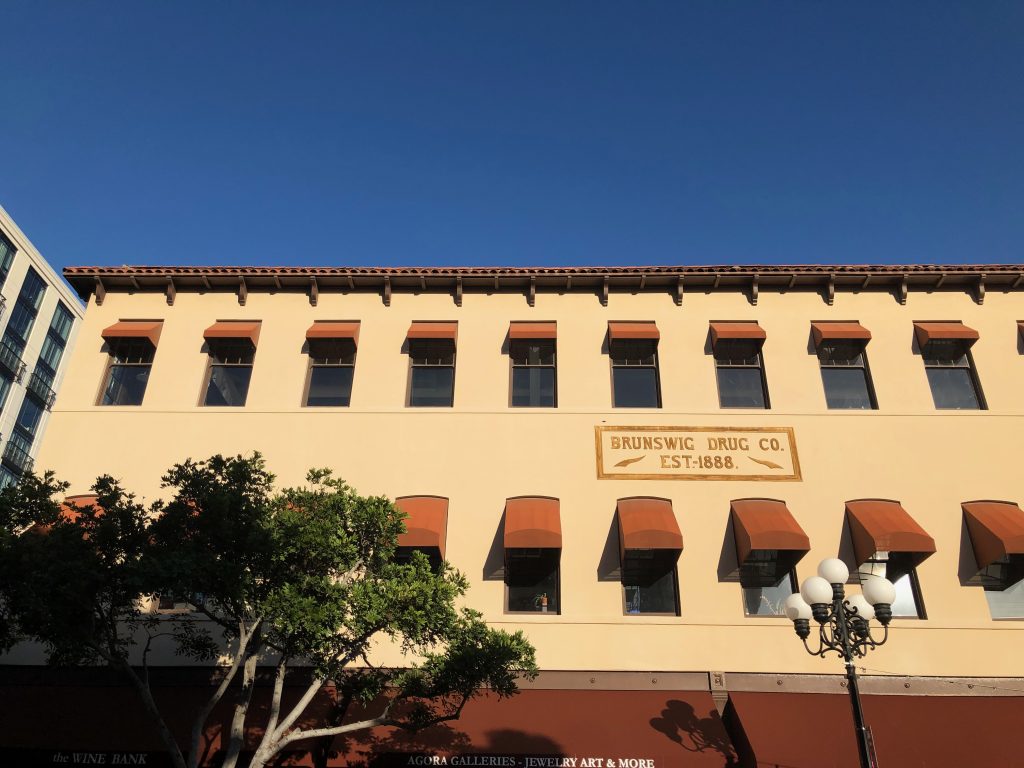No products in the cart.
Landmarks
Pick Your Poison!
Brunswig Drug Company
363 5th Avenue
Architectural Style – Spanish Revival
Architect: William Quayle – 1900
Quayle Brothers – 1925
Most of us can’t walk more than two or three blocks without stumbling across one of the many chain drugstores that populate our cities. Indeed, in the Gaslamp alone there are three CVS such establishments. However, these 21st century convenience stores aren’t the first chain drug emporiums to grace our city. Most don’t realize that the Brunswig Drug Company, which opened for business in 1908, was actually part of a chain that originated in Los Angeles.
From its original ownership by Mr. A. E. Horton (Alonzo Horton), the property changed hands often. It first had a frame structure on the lot and listed as tenants such businesses as a Chinese laundry, the Montana saloon, the “City of Paris” bakery, and wholesale grocers.
In June of 1899, Mr. B.A. Arnold acquired the property and started excavation for a two-story brick building. As soon as the first building was completed, he planned on building a second structure. The cost for both buildings was projected at $75,000. Arnold had intentions of creating a spacious business block, but his dream was abruptly halted when he unexpectedly died. His widow did not wish to go forward with the project, so she sold the parcel to Frederick W. Braun, owner of the F. W. Braun Company of Los Angeles. The company specialized in the wholesale drug business, catering primarily to miners, assayers and chemists. It was the biggest establishment of its kind on the Pacific coast.
As the excavation had been completed and the basement put in place before Arnold’s death, Mr. Braun continued with the construction. The new structure, later to be called the Brunswig Building, was a two-story brick building. The third story was added in 1925. The completed building was to house Mr. Brauns’s branch store in San Diego. It was of red brick and red mortar with a traditional storefront of iron columns and show windows. Divided storerooms were put on both floors and a total of 27,000 square feet of floor space was provided. Two hydraulic freight elevators were also installed, and are considered some of the city’s oldest freight elevators. The building was completed on December 8, 1900. The F. W. Braun Company opened its doors as a drug and wholesale paper business, and operated as such until 1908. At this point, Mr. Braun decided to retire, and sold his business to the company’s longtime 1st vice-president, Mr. Lucien Napoleon Brunswig. He did, however, stay on to assist with growing the wholesale portion of the business. The new company, the Brunswig Drug Company, boasted branches in Los Angeles, San Diego, San Francisco, Phoenix and Tucson. Mr. Brunswig was more interested in the retail side of operations.
As today, pharmaceuticals were a tricky business. There were pharmacy laws in place, which “prohibited the selling of poison without proper precaution or using unregistered pharmacists.” These unregistered pharmacists were often young boys studying to become pharmacists. They were usually told to look over the prospective client, determine if they were a “rational sort,” and then go ahead and sell them carbolic acid or large quantities of laudanum or whatever they requested. As these assistants were often left unsupervised, they had ample opportunity to practice their future trade. Customers were at their mercy and discretion.
Mr. Brunswig was a great inventor of commercial medications and patent medicines, which he also supplied to many of the city’s pharmacies. He additionally donated the School of Pharmacy at USC.
In 1915, the Brunswig Drug Company lost its second story as a result of a fire said to have been caused by alcohol , ignited not consumed. The building was repaired and a third story was added in 1925. At this time the inscription “1888” was put in place at the top of the front facade of the structure to indicate the date of the founding of the company. The Brunswig Drug Company continued to operate in San Diego until 1960. Mr. Brunswig passed away in 1943, and is buried in an elaborate mausoleum in Metairie Cemetery in New Orleans.
In 1970, the Brunswig Drug Building was purchased by Mike Farres, wine connoisseur and Gaslamp entrepreneur. He quickly realized that the basement of the building would make a perfect wine cellar, and consequently stocked it with varieties of wine from all over the world. He opened the Wine Bank on the ground floor, which became, and continues to be, a very popular wine store and showplace for fine spirits. As the Gaslamp was a very shady and rundown area in the 70s, Farres kept his door locked at all times, even during business hours. A prospective customer had to ring a buzzer, show himself at a window, and Farres would then make a determination as to whether he was a client or a crook before allowing him admittance. He perpetuated the statement that one had to be very wary where you walked in the Gaslamp. Talking down the neighborhood enabled him to purchase large quantities of Gaslamp real estate at bargain prices, and he became a wealthy land developer. He finally sold the Wine Bank to Paul Karcho in 2006. Karcho, a Michigan transplant, had been haggling with Farres for eight years before Farres relented and sold him the Wine Bank. Mr. Farres passed away in 2010. The Wine Bank is still going strong!
Sandee is the historian for the Gaslamp Quarter Historical Foundation. She can be reached at [email protected].

